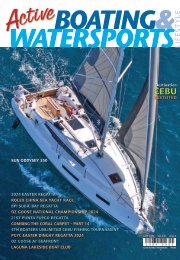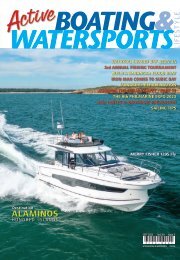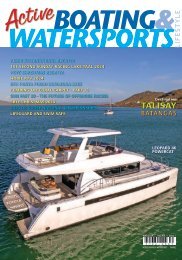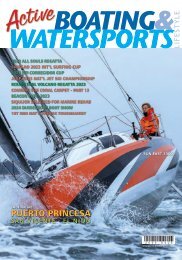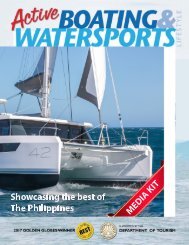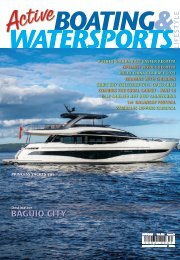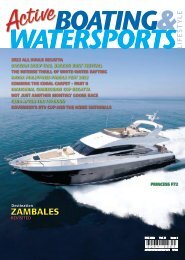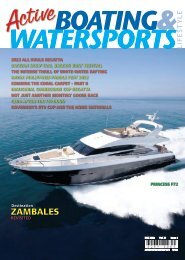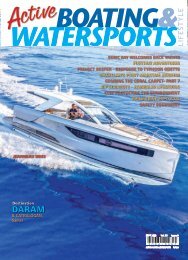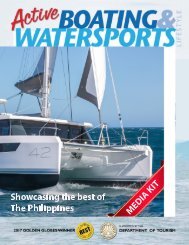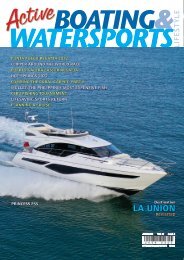You also want an ePaper? Increase the reach of your titles
YUMPU automatically turns print PDFs into web optimized ePapers that Google loves.
Article excerpts reprinted from the book<br />
CRUISER HANDLING<br />
by BOB BOND & STEVE SLEIGHT<br />
Sailing Tips<br />
You’ve always been interested to sail, but you know little about boat parts, the confusing techno-babble, and what<br />
little you know is making your head spin in four different directions! Worry no more. This continuing series of articles<br />
is for you: it covers tips regarding hardware present on most boats, as well as common sailing techniques, terms and<br />
definitions, the names of the different pieces of hardware, and much more. This will keep you informed about most<br />
things you will need before you begin your own sailing excursion. Be sure to consult with an experienced sailor and someone<br />
knowledgeable about boats.<br />
Apparent wind<br />
If the navigator draws the<br />
speed and direction of the<br />
apparent wind and the created<br />
wind to scale, joining the points<br />
A to C will give the direction<br />
and speed of the true wind.<br />
With the boat on a close reach,<br />
the true wind is weaker than<br />
the apparent wind, and comes<br />
from further aft. On a broad<br />
reach, left, the true wind is still<br />
from further aft but is stronger<br />
than the apparent wind.<br />
Steering with a tiller<br />
The helmsman’s role on a sailing boat is a vital one since he is<br />
directly in control of the boat’s course and performance. On<br />
every cruising boat there should be more than one person<br />
capable of steering proficiently on all points of sailing, in both<br />
open and congested waters.<br />
On any point of sailing, except close-hauled, the boat’s<br />
course is determined by the passage plan or chosen heading.<br />
Normally, the boat is pointed towards the destination, or a<br />
land or sea mark en route, or it is steered on an appropriate<br />
compass course worked out by the navigator. The helmsman<br />
must be able to steer a more or less accurate course (to a<br />
tolerance with 5° of the required heading) so that the navigator<br />
can then plot the course correctly. Beginners often use too<br />
much helm and the boat weaves a rather unsteady course as<br />
a result - all helm movements should be kept to a minimum.<br />
Steering to a visible mark is easier than steering a compass<br />
course. When sailing to a windward destination the boat will<br />
often have to tack several times and in these circumstances<br />
the helmsman should aim to get the best performance out of<br />
the boat, rather than steer to a predetermined heading, but<br />
he must make a note of the average compass heading he is<br />
steering and inform the navigator what it is, and if it changes.<br />
88<br />
Taking a transit<br />
Whenever you are sailing in tidal waters, the movement of<br />
the water in relation to the seabed will always affect the<br />
course you sail or your boat speed, or both. Most of the time<br />
it is the navigator’s job to calculate the effect of a tidal stream<br />
or current and to plot a course which will allow for it. However<br />
there are times, when sailing in sight of land, when you need<br />
to be able to adjust your course by eye to allow for a stream<br />
setting across your course. You can do this by taking a transit<br />
either ahead or astern of the boat. It consists of lining up two<br />
fixed points - land or sea marks - and steering the boat to<br />
keep them constantly in line. In a cross-stream you will have<br />
to point the boat uptide of your objective to keep the objects<br />
in line. If you do so, your boat will actually move crab-wise<br />
across the seabed, but you will achieve the most direct and<br />
the quickest course to your chosen destination.<br />
Steering a compass course<br />
Every boat should have at least one large compass fixed<br />
to the cabin bulkhead or some other point where it can be<br />
clearly seen by the helmsman, from either side of the boat.<br />
Most ocmpasses show the course on a card which is marked<br />
in degrees from 0° to 359°, clockwise around its face. To steer




